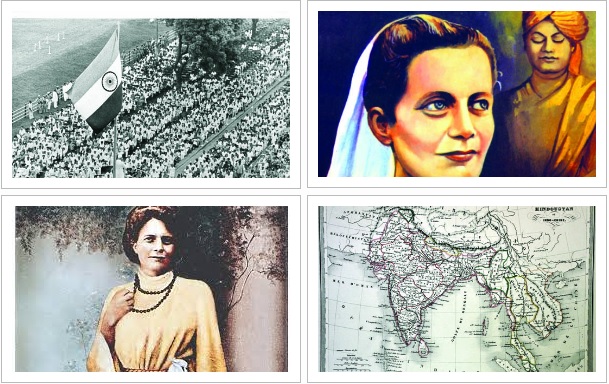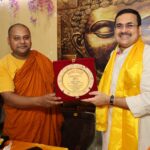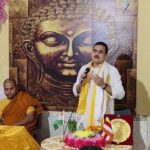Sister Nivedita: Struggle for the ‘Consciousness of Unity’
- By : Anirban Ganguly
- Category : Articles

A beacon of true patriotism, Sister Nivedita’s devotion to her Mother India was unflinching even in the face of deepest adversity.
Sister Nivedita’s gradual identification with Indian conditions and aspirations eventually saw the dissolution of her early aspiration of bringing India and her coloniser together. Her increasing exposure to Indian politics, to Vivekananda’s words and her own work among Indian nationalists and intellectuals, who were struggling to restate India in several fields, brought about in her a complete identification with her adopted mother country. India, “Mother India” had become ‘her Ishta, the supreme object of her devotion, in which she perceived the aim of her life and the peace of her acceptance.’
She was often seen becoming ‘deeply meditative’ whenever the topic veered round to India. In this, she followed her Master, whose own obsession with India, Nivedita admirably described in her assessment of him. ‘If any talk of India arose’, recalled one who had closely collaborated with her in the girl’s school project, ‘she would become deeply meditative and say to the girls, ‘Bharat Varsha! Bharat Varsha! Bharat Varsha! Mother! Mother! Mother! India’s young girls, you must all repeat, Bharat Varsha! Bharat Varsha! Bharat Varsha! Ma! Ma! Ma!’, so saying, she would take her rosary and start doing japam herself. That India was the soul of her soul, the heart of her heart, ever so dear and sacred to her, cannot be expressed in mere words.’
Young students who came in touch with her, the students of the Vivekananda Boarding House, which she had conceived and helped set up, often met her and were moved by her uncontrolled sense of oneness when it came to India. At the end of a discussion on Dharma with the boys of the Vivekananda Boarding House, sometime in September 1903, Nivedita exhorted them first to ‘Know your Motherland – your great MOTHER! MOTHER BHARAT VARSHA! You must not discriminate, distinguish or differentiate between them – Mother country or Mother.’ She urged these young minds, forming the kernel of nationalist workers that she hoped to steadily churn out someday, to ‘go round Her, to know Her people, their religion, culture, literature, language, customs and traditions’ and their history. She directed them to mix with them [other people of India] intimately, often, whenever such an opportunity occurs, to love them. Just as a son or a daughter behaves or mixes with his or her mother freely and intimately, so you should love Her, respect Her, serve Her, worship Her with the most reverential salutations! She had succeeded in internalising this sense of a deeper underlying unity in this land of apparently conflicting diversities. It is largely due to Sankari Prasad Basu (1928-2014), the indefatigable chronicler of the Swami’s life and times and Sister Nivedita’s biographer, that we have these very interesting insights into how Nivedita inspired and instilled the seeds of patriotism and nation-worship into young minds.
A student at the Vivekananda Boarding House, Pramathranjan Pal, recalled how Sister came along one day with a map of India, six-feet by five-feet, and requested the resident Swami, in charge of the hostel, to allow her to fix it on the wall; and having fixed it, how she spoke of the need to superimpose patriotic emotions and see in this map a projection of India as the mother, as an emanation, a living and pulsating entity:
“My dear boys, you have all read geography in your school days. What you have read, heard, or seen was only about the physical features of India’s mountains, hills, rivers, lakes, deserts etc. The map which you see now hung on the wall before you is not merely a vast sheet of paper in print, but this is the picture of your Mother. From Kashmir to Kumarika is a living and throbbing entity. The mountains, the hills are Mother’s bones, the rivers and streams are her arteries and veins. The vacant spaces you see are not mere heaps of clay, mud or sand but her flesh. The trees, plants are her hairs…” (Nivedita Lokmata, S.P. Basu, Vol.2, p.138)
She reminded her young audience of how in their motherland a number of great souls were born over the ages, how it had created some of the greatest epics that mankind has ever produced, how their sacred cities were replete with legend, philosophy and wisdom, how some of the greatest political, economic, governance and statecraft treatises were produced in this land. ‘Wherever you go, Mother’s portrait which you see here, let it occupy the centre of your heart and Her thoughts crowd your memory.’ With her voice choking with emotion, she exhorted the young boys to shut their eyes for a while and to try and visualise the inner dimension of India their motherland. Nivedita herself had succeeded in internalising this sense of a deeper underlying unity in this land of apparently conflicting diversities. She realised that a wave of consciousness and aspiration for freedom would have to be generated among the people, so that the revolution, the struggle for freedom could crystallise, gain momentum and have a distinct voice. She inspired young revolutionaries who had decided to consecrate themselves to the task of liberating India. One of them, among the most daring and most intellectually alive, Jatindranath Mukherjee (1879-1915), known in the pages of history as Bagha Jatin had his first meeting with Vivekananda because of her. It was this meeting with Vivekananda that firmly planted, in young Jatindra, the will to freedom.
Post, Vivekananda’s passing, after she had regained her poise and strength, Nivedita resolved to plunge into the vastness of India. She felt empty and yet she could not grieve, as she confided to one of her friends, “He is not dead; he is with us always. I cannot even grieve. I only want to work.” This work was the work of India’s liberation and cultural self-recovery.
One of her most widely read biographers, Pravrajika Atmaprana argues for example that, during her European and American tours, Nivedita ‘keenly felt that a country under foreign domination cannot dream of regeneration – social, political or cultural’ and ‘political freedom was the point to start with.’
From 1902 to 1904, Nivedita went on extensive lecture tours across India ‘urging people to realise the need of the hour and strive to make India free and great.’ The three things that she aspired to instill in those whom she reached out to, in her case mainly the youth, intelligentsia, opinion makers and political leaders, was the need to ‘first, have infinite faith in their own reserve power; second, to gain all-round strength to free themselves from the shackles of the foreign government; and third, to realise that the advent of Sri Ramakrishna and Swami Vivekananda was to give light to those who walked in darkness. All her writings and speeches of this period reverberate with these sentiments.’
She had clearly visualised for herself a role in public affairs, in activism and in contributing her might to rousing the spirit of freedom. As Sankari Prasad Basu notes in some detail, Nivedita realised that the consciousness for freedom, the aspiration for liberation could be generated through a determined dissemination of Swami Vivekananda’s thoughts and words and her work defined itself in the following dimensions: to articulate how Vivekananda’s thought was one of the driving forces of patriotism, to achieve that end she decided to tour the length and breadth of India, to speak to the youth, to address gatherings and more importantly, to establish contact with groups of workers, to work towards channelising the emerging consciousness for freedom, to establish organisations or associations to achieve this objective and where found to be difficult, to co-opt existing institutions and movements, to expose the anti-people policies of the colonial establishment and to expose its weak areas and links, to work for the strengthening of a national sense of self-respect, to work for India’s unity through an infusing of the national psyche with the feelings of patriotism and nationalism and along with these, to work to foil conspiracies to defame and denigrate Indian culture as a whole such as countering the anti-India propaganda of Western missionaries and, among other things, to design and prepare a symbol, a flag that would be reflective of the movement for unity and political emancipation.

















